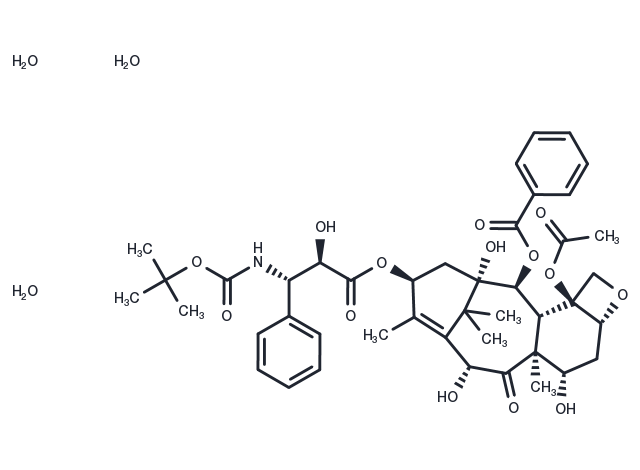Powder: -20°C for 3 years | In solvent: -80°C for 1 year


Docetaxel trihydrate (RP-56976 Trihydrate) is an antineoplastic agent that has a unique mechanism of action as an inhibitor of cellular mitosis and that currently plays a central role in the therapy of many solid tumor including breast and lung cancer. Therapy with docetaxel has been associated with a low rate of serum enzyme elevations and rarely to instances of acute hepatic necrosis generally due to severe hypersensitivity reactions or sepsis.

| Pack Size | Availability | Price/USD | Quantity |
|---|---|---|---|
| 100 mg | In stock | $ 46.00 | |
| 1 mL * 10 mM (in DMSO) | In stock | $ 50.00 |




| Description | Docetaxel trihydrate (RP-56976 Trihydrate) is an antineoplastic agent that has a unique mechanism of action as an inhibitor of cellular mitosis and that currently plays a central role in the therapy of many solid tumor including breast and lung cancer. Therapy with docetaxel has been associated with a low rate of serum enzyme elevations and rarely to instances of acute hepatic necrosis generally due to severe hypersensitivity reactions or sepsis. |
| In vitro | Administering 33 mg/kg of Docetaxel every four days for three doses resulted in a 19.3-day growth delay in M2OL2 colorectal cancer xenografts. Docetaxel exhibited potent antitumor activity in MX-1, SK-MEL-2, LX-1, and OVCAR-3 xenograft models. Biweekly administration of Docetaxel over 14 days suppressed fibroblast growth factor 2-mediated angiogenesis with an IC50 of 5.4 mg/kg. A dose of 10 mg/kg Docetaxel completely inhibited angiogenesis in mice. |
| In vivo | Docetaxel inhibits the clonogenic survival of various human cancer cell lines including Hs746T (stomach), AGS (stomach), HeLa (cervical), CaSki (cervical), BxPC3 (pancreatic), and Capan-1 (pancreatic) with IC50 values of 1 nM for the stomach, and 0.3 nM for the others, respectively. Additionally, Docetaxel suppresses the chemotaxis of human umbilical vein endothelial cells stimulated by angiogenic factors, thymidine phosphorylase, or VEGF, with an IC50 of 10 pM. Moreover, Docetaxel induces the expression of Prostaglandin H Synthase-2 (PGHS-2) in human monocytes without affecting its expression in RAW 264.7 mouse macrophages. |
| Cell Research | 2000 cells in 180 μL of medium are seeded in a 96-well plate, and 20 μL of drug solution is simultaneously added in triplicate to each well. The plate is incubated for 3 days at 37°C in a humidified atmosphere of 5% CO2. On day 3, 25 μL of MTT reagent is added to each well. After 4 h of incubation, the medium is removed by aspiration. 0.2 mL of dimethylsulphoxide (DMSO) is added to each well and thoroughly mixed by using a mechanical plate mixer to dissolve the resulting MTT-formazan crystals. Absorbance at 540 nm (OD) is measured by a reader. (Only for Reference) |
| Synonyms | RP-56976 (Trihydrate), RP56976 (NSC 628503) Trihydrate |
| Molecular Weight | 861.95 |
| Formula | C43H59NO17 |
| CAS No. | 148408-66-6 |
Powder: -20°C for 3 years | In solvent: -80°C for 1 year
Ethanol: 100 mg/mL (116.01 mM)
DMSO: 100 mg/mL (116.01 mM)
H2O: < 1 mg/mL (insoluble or slightly soluble)
You can also refer to dose conversion for different animals. More
bottom
Please see Inhibitor Handling Instructions for more frequently ask questions. Topics include: how to prepare stock solutions, how to store products, and cautions on cell-based assays & animal experiments, etc.
Docetaxel trihydrate 148408-66-6 Apoptosis Cytoskeletal Signaling Microtubule Associated BCL inhibit RP-56976 (Trihydrate) Inhibitor RP-56976 RP56976 (NSC 628503) Trihydrate Docetaxel Trihydrate Microtubule/Tubulin RP56976 Docetaxel RP56976 (NSC 628503) RP 56976 inhibitor
